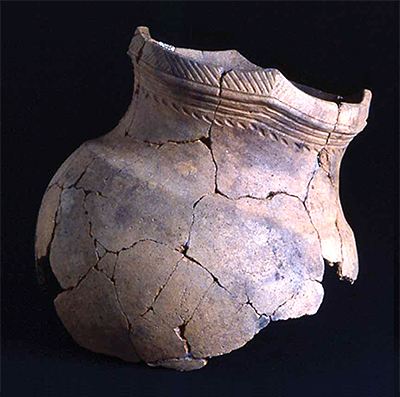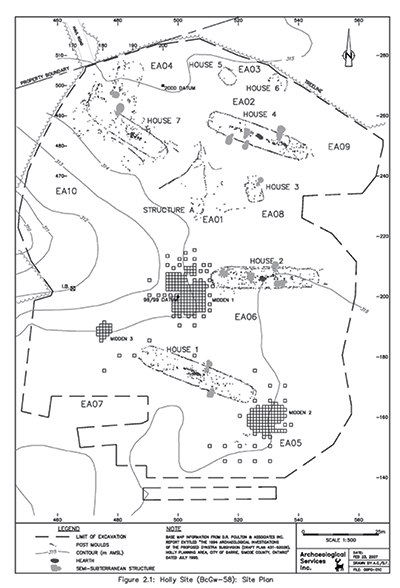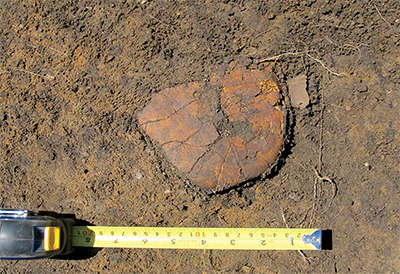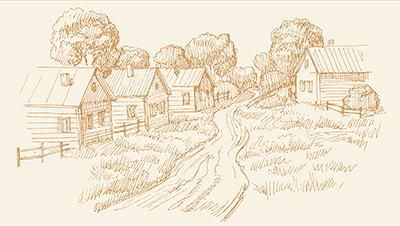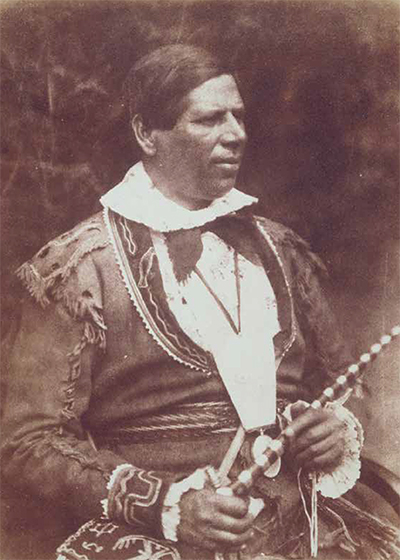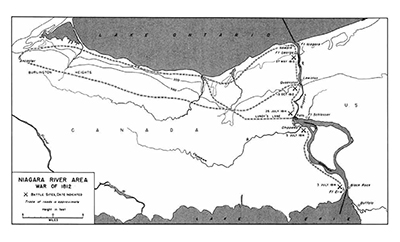The folk-lore of the Wyandots should be peculiarly interesting to Kansas students. It will be conceded, that the emigrant tribes were in every way superior to the native tribes of Kansas Indians. The Wyandot were the recognized head of the emigrant tribes. And this superiority had been accorded them by the emigrant tribes themselves. It was of ancient date and long standing. As early as 1750 the Northwestern Confederacy was formed, and the Wyandots were made the keepers of the council-fire thereof. In 1848 this Confederacy was renewed in Kansas at a great council held near Fort Leavenworth, and the Wyandots confirmed in their ancient and honorable position. As a tribe the Wyandots favored the organization of Nebraska (Kansas) Territory. Indeed, they made the first effective efforts in this direction. They established a Provisional government at the mouth of the Kansas river, in 1853. The first man to bear the title of Governor of Nebraska (Kansas) was William Walker, a Wyandot Indian, a gentleman of education, refinement, and great strength of character. The metropolis of the 8 State is but the development of a Wyandot village into a great modern city.
This will not seem strange when it is known that Wyandots were even that time of more than one-half white blood. There is not so much as a half-blood Wyandot now living. The last full-blood Wyandot died in Canada about 1820.
The generation now living could furnish no folk-lore of value. Few of them speak their language. Not half a dozen of them can speak the pure Wyandot. Their reservation near Seneca, Missouri, the Indian Territory, is not different from the well till-ed portions of our country. They are good farmers, and have schools and churches. Stih-yeh’-stah, or Captain Bull-Head, was the last pagan Wyandot; he died in Wyandotte county, Kansas, about the year 1860. In the Journal of American Folk-Lore for June, 1899, I published a paper on the “FolkLore of the Wyandots.
American folk-lore is the result of the foregoing principles applied to the Indians, the aboriginal inhabitants of our country. For the white race in America have not become a people with a distinct folk-lore. We are yet developing the Gaelic, Saxon, German and other folk-lores. So the term “American folk-lore” as yet applies only to that of the aborigines. We find in the North-American Indians many distinct families and all degrees of mental strength. The folk-lore preserved indicates that this has always been true.
I.-NAME. Lalemant says the original and true name of the Wyandots is OUENDAT. In history the Wyandots have been spoken of by the following names:
1. Tionnontates,
2. Etionontates,
3. Tuinontatek,
4. Dionondadies,
5. Khionontaterrhonons,
6. Petuneux or Nation du Petun (Tobacco).
They call themselves 1. Wehn’-duht, or 2. Wehn’-dooht. They never accepted the name Huron, which is of French origin. It is not certain that they were entitled to the name Huron. They make no such claim themselves. The Wyandots have been always considered the remnant of the Hurons. That they were related to the people called Hurons by the French, there is no doubt, and upon this point there is no dispute and can be no question.
In 1855 the Wyandots made a treaty in which they dissolved their tribal relations and
received their land in severalty, and became citizens of the United States. In 1867 the
Government allowed such of them as desired to do so to resume their tribal relations,
and purchased them a reservation of 20,000 acres from the Senecas, in the Indian
Territory. This reservation is near Seneca, Mo., and the Wyandot tribe live on it at the
present time. This land is allotted to them, and is in a good state of cultivation, they
being good farmers, and an industrious and orderly people. They maintain schools for
their children, and many of them are members of the churches of the Methodist and
Quaker denominations. They have good dwellings; and much stock, consisting of hogs,
cattle and horses, is raised and sold. The thriving little town of Wyandotte, on the Frisco
railroad, is the metropolis of their country. It is situated in one of the most beautiful
valleys in the Indian Territory.
III.–RELIGION. The gods of the Wyandots were those of the Iroquois and the Hurons, but they were stamped with a strong Wyandot individuality, and in many respects differed in attributes from those of the nations named. The Wyandot was more Iroquois than he was Huron-Iroquois, and he was but little different from the Seneca; It need surprise no one if it is finally determined that the Wyandots were the oldest of the Iroquoian family.
The myths of the woman who fell from heaven, the creation
of the great island, the birth of the twins, the enlargement of the great island and the
peopling of it with man and animals, the destruction of these and their re-creation, the
creation of the sun, moon and stars, and many others, are but little inferior in their bold
originality and beauty of conception to the Greek myths.
The Wyandots gave names of their own to the God of the white man, but as it is our
intention to omit an Wyandot words as far as possible, these names are not given. The
conception of the Great Spirit, which has been attributed to the Indians, was given them
by early missionaries. No Indian tribe ever had such a conception until after contact
with Europeans. It is certain that no single “Supreme Ruler,” or “Creator of the
Universe,” or of even the world, or any “Manitou” or “Great Spirit” was believed in or
conceived of by the ancient Wyandots.
Wyandots believed there was a world above this, ruled over by a mighty chief. This chief seems to have been immortal. His name might be expressed as the Chief above the sky, or the Mighty Ruler. He ruled the world above the sky, and was the father of the Woman who fell down from heaven. Many supernatural powers were attributed to him. Whether or not the belief in his supernatural powers is the result of a degeneracy of the ancient Wyandot faith from contact with the foreign belief of a stronger people, it may be impossible to satisfactorily determine. But that this belief has existed from time immemorial is the claim of the old Wyandots with whom I have talked upon the subject; and there is nothing to disprove their averment. I may say that it is certain that he was regarded as were Eataentsic and Jouskeha by the Hurons, as recorded by Le June: “This god and goddess live like themselves, but with-out form, make feasts as they do, are lustful as they; in short, they imagine them exactly like themselves. And still, though they make them human and corporal, they seem nevertheless to attribute to them certain immensity in all places.”
THE GOD OF NATURE. The Wyandots had a god of the Forest and all Nature. His name means “The Great One of the Water and the 41 Land.” He was the deification of the mythical Tseh’-stah, the Good One of the Twins born of the Woman who fell from heaven. His name is only a variation of the name of Tseh’-stah, with the attribute of greatness added. The Wyandot god of Nature was the Jouskeha of the Hurons. The Wyandot and Huron accounts of his birth differ. Parkman identifies him with the sun. The Wyandots explain the creation of the sun by a different myth. They say the sun was made by the Little Turtle, at the in-stance of the Animals in Council assembled. But the god of Nature, notwithstanding, was the most important god of the Wyandot Mythology. He made the corn, tobacco, beans and pumpkins grow; he provided fish and game for the people.
Wyandots worshipped him at any time, or
at any period of their history. His place of abode was not definitely fixed by them,
although he was supposed to live somewhere in the East. They thought that he often
manifested him-self to them, being seen in the forests, fields, lakes and streams. If the
stalk of corn seen in his hand was full eared, when-grown, and perfectly grained, a
bountiful harvest was indicated; but if it was blasted and withered, no corn was to be
expected, and famine was imminent. If he carried in his hand the bare bone of fish or
game, it was certain that none of either could be taken or killed for a season.
THE GOD OF DREAMS. The Wyandot had a god of Dreams. The name signifies “The Revealer,” or “He makes the Vision,” or “He makes the Dream.” He was supposed to have something to do with the supernatural influences that acted upon this life, and he revealed the effects of these influences to the Wyandots in dreams. An visions and dreams came from him, for he had control of the souls of the Wyandots while they slept or were unconscious from injury or from disease. The medicine man could detach his soul from his body and send it to the god of Dreams for information at any time, and during its absence he was in a trance-like condition. As all dreams and visions were considered direct revelations from the Dream god, they were regarded as of the very highest significance and of the first importance. No god of the Wyandots was held in higher esteem – no other exerted so great an influence directly upon their social institutions as the god of Dreams. Even to this day the Wyandots attach supreme significance to their dreams.
THE ANIMALS. The Wyandot mythology endowed the ancient Animals with great power of the supernatural order. This is especially true of those Animals used by them as totems or clan insignia, and from whom they were anciently descended. Of the Animals, the Big Turtle stands in first place. He caused the Great Island (North America) to 45 grow on his back, for a resting-place and home for the Woman who fell down from heaven. He is supposed to carry the Great Island on his back to this day. The Little Turtle is second in rank and importance in the list of Animals. By order of the Council of these Animals he made the Sun; he made the moon to be the Sun’s wife. He made all the fixed stars; but the stars which “run about the sky” are supposed to be the children of the Sun and Moon. The Sun, Moon and Stars were made for the comfort and convenience of the Woman who fell from heaven. To do this it was necessary for the Little Turtle to go up to the sky, and this difficult matter was accomplished by the aid of the Thunder god. The Deer was the second Animal to get into the sky; this he did by and with the assistance of the Rainbow. And after-ward all the other totemic Animals except the Mud Turtle went up to the sky by the same way, and they are supposed to be living there to this present time. The Mud Turtle is appointed to rule over the land of the Little People, in the interior of the earth. The Animals seem to have governed the world before the Woman fell from heaven, and for some time after that important event. Among the Animals mentioned by the Wyandots as living here before the Woman’s advent are the Big Turtle, the Little Turtle, the Toad, the two Swans, the Otter, the Beaver, the Snake, the Bear, the Wolf, the Hawk, the Deer, the Porcupine, the Muskrat, and many others. Where and how the land animals lived when all was covered with water is not explained. In the ancient mythology these land animals may have been absent or wanting until after the creation 46 of the Great Island, but I heard them spoken of as contemporaneous with the Turtles, the Toad, and the Swans.
THE WOMAN THAT FELL FROM HEAVEN. The Woman that fell from heaven is an important personage in the Wyandot mythology. No supernatural powers were attributed to her
But that she remained here is to be inferred, for in the great Yooh’-wah-tah’-yoh she had charge of the Wyandots while her son went forth to re-create the works of the world. She was directed by her father what to call the Twins, and the myth leaves the inference that she brought them up, but I was never able to get any positive statement to that effect. She is again unlike the Huron Eataentsic in having nothing to do with the destinies of the world and its inhabit-ants.
After the birth of the Twins, no further consideration in this life was accorded the Woman that fell from heaven. She was assigned a station in the great under-ground city or Yooh’-wah-tah’-yoh, to assist the souls of all dead Wyandots on their way to the land of the Little People. On the Great Island this Woman that fell down from heaven found living an old woman who took her to live with her in her lodge, and whom she called Shooh’-tah’-ah, i. e., her Grandmother. Her sole office seems to have been to furnish a home to the Woman that fell from heaven- – a lodge, a home.
Barbeau CM Huron and Wyandot Mythology. P 310-311 talks about the story of the underground city of Yooh-wah-tahyoh, built in ancient times by the God Tseh-stah beneath the surface of Canada.
THE LITTLE PEOPLE.
The Little People occupy an important place in Wyandot mythology. Their name
signifies “The Twins.” This name seems to have been given them for several reasons.
First, they were the only people made by Tseh--stah, except the Wyandots, and for this
reason the Wyan50
dots called them a Twin People to themselves. Second, they were created in pairs; and
they were born in pairs, or twins, only. They never operated singly in the
accomplishment of any enterprise; and only in very rare in-stances were more than two
of them required for the performance of any task or purpose, however great or severe.
Two of them expelled the Witch Buffaloes from the Big Bone Licks in Kentucky. The
Wyandots claim that the footsteps of these two of the Little People that expelled these
Witch Buffaloes, and also the impressions left by them when and where they crouched
down, can be yet plainly seen in the huge masses of stone all over that part of Kentucky
in the vicinity of these Licks.
Tseh’-stah created the Little People to aid him and the Wyandots to overcome Tah’-wehskah’-reh and his people in the war in which the first creation was destroyed. They were of very diminutive size, but they possessed marvelous supernatural powers. They lived (and they are supposed to live yet) in stone caves in the bowels of the earth; but in these caves are forests, streams, game, night and day, heat and cold, as on the surface of the earth. These Little People are represented as living precisely as the ancient 51 Wyandots lived, and as having the laws, customs, social organization, political and religious institutions of the ancient Wyandots, and these it is their task, duty and pleasure to preserve in all their primeval purity for the Wyandots to have and to use in this land, to which they will go after death. The Little People were regarded as the guardians of the Wyandots both in this world and in the world to come.
They have the power to
enter and pass through solid rock, and they always pass through the “living rock” in
returning to their subterranean home; and this home is pictured as one of ideal beauty,
according to the Indian standard, but no one in all the realms of Indian imagination,
natural or supernatural, ever has or ever can see this beautiful country except the Little
People, until after death, when it is to be also the abode of the Wyandots. It is ruled now
by the Mud Turtle who made it, but at the end of time the Woman who fell from heaven
is to take charge of it as ruler.
THE WITCH BUFFALOES. In the land of Silence, Tseh’-stah made the largest and most beautiful Spring in all his dominions. This is now the Big Bone Licks in Boone county, Kentucky. It is “ the big Spring which flowed in ancient times,” and which may be properly rendered “ The Great Ancient Spring.” The modern Wyandot name for it is Oh’-tseh- yooh’-mah, “ The Spring of bitter water.” Tseh’-stah made this spring at this point because here stood the lodge of Shooh-tah’-ah, with whom* dwelt the Woman that fell down from heaven. The Two Children were born here. From this Spring, which was then small, drank “ The Man of Fire “ and “ The Man of Flint,” in the days of their childhood. As enlarged by Tseh’stah the Ancient Spring was so broad that the eye could not see from one bank to the other. Its waters were so clear that the smallest pebble could be seen at the bottom of its inconceivable depths. Then it was the “ Great Ancient Spring.” As modified by Tah’-weh-skah’-reh it was reduced to its present size and became Oh’- tseh-yooh’-mah, “ The Spring of bitter water.” The Wyandots described these Springs as “the great and ancient Spring where the bones are and where the animals come to drink and to see each other.” Tah’-weh-skah’-reh made a great drum or gong, of stone 90 or flint, and put it at these Springs. He put in charge of the Springs the Witch Buffaloes, who made unjust rules and oppressive regulations for the government of the Indians and animals coming to use the waters. Elks were admitted to the Springs ; when they had been there a stated time they were forced out, and buffaloes admitted, and so of all the animals. The Witch Buffaloes indicated their wishes, and gave forth their orders and commands by beating on the great drum of flint, which could be heard as far as the Great Lakes. The Witch Buffaloes are represented as having been as tall as a tree, with horns as long as a man is high. Their horns stood straight out from their foreheads. They are always spoken of in the feminine gender. So oppressive became the Witch Buffaloes that no animal was free to approach the Springs, and thus were the Wyandots prohibited from lying in wait to slay them for food as they came to drink. Neither were the Wyandots allowed to go there to make salt. Finally the Little People took pity on the Wyandots and resolved to destroy the Witch Buffaloes. Two of the Little People were directed to go to the Springs to perform this difficult task. It required long preliminary work to make ready for the slaughter. When all was ready they attacked the Witch Buffaloes and slew all but a single one, which they wounded, and which only escaped by so enormous a leap that it passed beyond the Great Lakes at the single bound. After the Witch Buffaloes were killed and expelled, the Little People assembled all the animals and said to them and to the Wyandots, “ Drink as you will. We are forever the keepers of the 91 Oh’-tseh-yooL’-mah.” The great number of huge bones found by white men at the Big Bone Licks were the bones of the Witch Buffaloes. The footprints of the two Little People can be yet seen in the stones all over that part of Kentucky about these Springs. They made them while driving all the Witch Buffaloes to the Springs for slaughter. At some points may be seen also the impressions of their bodies and of their bows and quivers on the stone where they sat or lay down. So say the legends of the Wyandots.
The Hooh’-strah-dooh’ were medicine men as well as Giants. They were clad in coats of
pliable stone. These
92
garments are represented as covering the body completely. Their stone coats were made
by smearing the crude turpentine from the pine tree over their bodies, and then rolling
in the dry sand of the shores of the Great Water. This process was repeated until the
coats were of the required thickness.
The Hooh’-strah-dooh’ were cannibals. They slew the Wyandots for the express purpose
of devouring their bodies. They are represented as having been half-a-tree tall, and large
in proportion. A Hooh’-strah-dooh’ could eat three Wyandots at a single meal.
There is no account of any particular war between the Wyandots and the Hooh’-strahddoh’. The Wyandots seem to have been annoyed and plagued by them from time
immemorial; and always to have been in terror of them. Sometimes they combined in
great numbers and attacked one of the Hooh’-strah-dooh’. If by any great good-fortune a
chance arrow reached one of the vulnerable points (eyes, mouth, etc.) the Wyandots
were victorious; if no such good-fortune attended them in the unequal combat, a bundle
of blood-stained, dripping Wyandot slain was carried from the fatal field on the back of
the victorious and bloodthirsty Stone Giant for his supper.
The Wyandots sought the aid of the Little People in an effort to expel or conquer the
Stone Giants. After a long contest they were divested of their stone coats, and so far
reduced that they did not dare to openly attack the Wyandots again. But they lived in
solitary places, and attacked hunters and travelers that slept at night in the woods. A
favorite stratagem of theirs was to enter the dead body of some Wyandot that had died,
in a solitary
93
hut, alone. When his friends discovered him, or a belated traveler stopped at the hut,
and slept, the Stone Giant animated the corpse, which stealthily slew and devoured the
unfortunate sleepers. A “medicine” made of the bark of the deh’-tah-tseh’-ah, or red-bud
tree, was supposed to afford the Wyandots complete protection from such attacks “of
the conquered Stone Giants.
THE SINGING MAIDENS, OR THE ORIGIN OF THE PLEIADES.
The pleiades have ever been favorite stars with mankind. And they were so with the
Wyandots. They believed the constellation consists of six stars, only. The Wyandots
account for the origin of this beautiful star-group in the following myth:
The Sun and his wife, the Moon, had many children. Among these were six little girls,
the daughters of a single birth. They were beautiful, kind, gentle and loving children.
They were great favorites in all the heavens, for they loved to go about and do good. In
addition to their other accomplishments, they were the sweetest singers and the most
tireless and graceful dancers in all the sky-land. They were called the Singing Maidens.
Bibliography
Barbeau CM Huron and Wyandot Mythology.
Valiant's Thor Guide to the Underworld
https://www.wyandotte-nation.org/wp-content/uploads/2012/08/Wyandot-Folk-Lore.pdf
The Fascinating Teachings of Valiant Thor by Liliana Usvat
















